
Money orders can be replaced if they are damaged, lost or stolen, but the process isn’t always easy, nor is it free. You’ll have to return to the place where you purchased the original money order and provide information proving you purchased it. After checking to see whether it was cashed or not, you may get a new one – but there’s no guarantee.
Know the Serial Number
When you purchase a money order, you will receive a receipt that contains its serial number. To get a replacement money order, you usually need to have that number handy. If you don’t, the establishment you purchased it from may be able to track it down, but the process will take longer and you risk having your request denied. Before heading down to the place where you purchased your money order, first call ahead or visit the company's website to familiarize yourself with its policies. This will let you know what you need to have in order to replace your lost, stolen or damaged money order –if it is at all possible.
Pay the Fee and Wait
Expect any resolution on a replacement money order to take weeks, if not months, to arrive. Between 30 and 60 days is the customary wait that institutions cite as the timeline for resolution. Also expect to take out your wallet, because most money order issuers charge a fee to replace lost money orders. The United States Postal Service, for example, makes you fill out PS Form 6401, then submits a payment inquiry to determine the status of a lost or stolen money order before issuing a replacement. It also charges a $5.95 processing fee for this service. MoneyGram charges a $18 processing fee that either must be included with the application or is deducted from the refund amount.
Take Appropriate Precautions
Losing or replacing money order is a hassle, however, there are a few things you can do to ensure this does not happen in the future. First, when you purchase the money order, fill it out immediately, leaving nothing blank. A blank money order is just as good as cash in someone's hand because he can fill it out with his own name, instead of the person you intended, and cash it. Keep your money orders in a safe place until you are ready to mail them or give them to the recipient. This may seem like common knowledge, but many times money orders are handed over to you with the receipt. If you're distracted when you receive the money order, you may accidentally throw it away or forget where you've stashed it. Lastly, always keep the receipt or stub from your money order until you know your recipient has cashed it.
References
- USPS: Money Orders
- MoneyGram: Money Order
- United States Postal Service. "Sending Money Orders." Accessed Jan. 13, 2020.
- Western Union. "Do Money Orders Have an Expiration Date?" Accessed Jan. 13, 2020.
- Western Union. "How Do I Request a Money Order Refund?" Accessed Jan. 13, 2020.
- United States Postal Service. "Money Orders - The Basics." Accessed Jan. 13, 2020.
- United States Postal Service. "Money Order Inquiry System." Accessed Jan. 13, 2020.
- MoneyGram. "Money Order Information." Accessed Jan. 13, 2020.
- MoneyGram. "Money Order Claim Card." Accessed Jan. 13, 2020.
- Western Union. "All About Money Orders." Accessed Jan. 13, 2020.
- Western Union. "Money Order Research Request." Accessed Jan. 13, 2020.
- Office of the Comptroller of the Currency. "Answers About Forgery and Fraud." Accessed Jan. 13, 2020.

